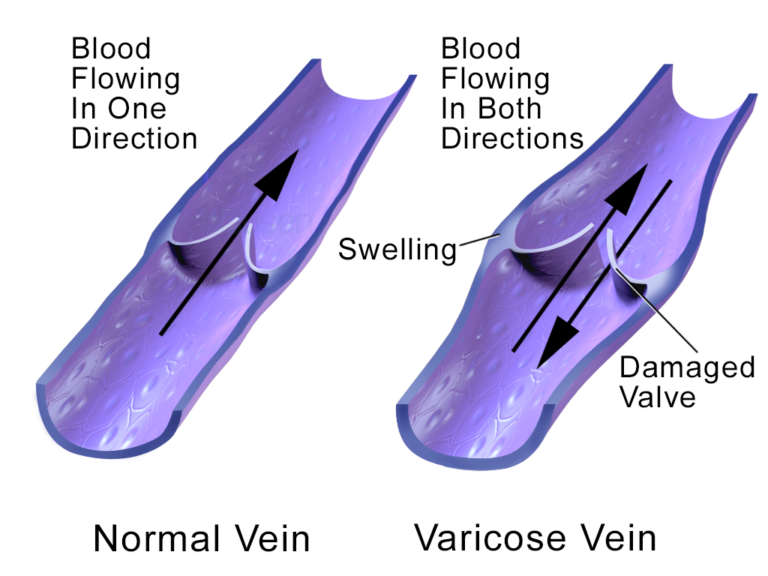
Vein problems are serious conditions that can interfere with daily living if left untreated. Blood clots and weak or damaged veins can interfere with the crucial role veins play in the cardiovascular system. While arteries carry oxygen-rich blood from your heart to all parts of they body, veins, transport blood back to the heart to be reloaded with oxygen.
According to the Vascular Disease Foundation, “. . . by the age of 50, nearly 40 percent of women and 20 percent of men have significant leg vein problems.”
Two types of inadequate venous drainage (venous insufficiency) include superficial (varicose veins) and deep (chronic venous insufficiency). Both of these types can reuls in ulcers and swelling and discoloration of the legs.
Varicose Veins
Superficial venous insufficiency is also known as varicose veins. These are dilated, snake-like segments of veins that lie just below the skin. In the absence of a blood clot, varicose veins are most likely due to failure of valves in the veins, allowing back flow of blood and increase in pressure within the leg veins. Valves, which prevent back flow of blood, may become damaged, resulting in pooling of blood within the veins.
Causes
They are more common in women and tend to run in families. Obesity, pregnancy, prolonged standing, and a sedentary lifestyle may exacerbate this condition.
Symptoms
Prominent veins and tend to be less severe in the morning after a night of leg elevation in bed and can worsen through the day with standing. Occasionally, without proper care, varicose veins may progress and cause skin ulcers, skin infections, and spontaneous bleeding.
Treatments
Standard therapies for varicose veins are exercise, weight loss, blood pressure control, and compression stockings. Compression stockings are specially fit and apply pressure to prevent the veins from being engorged with blood and thus from worsening over time. The stockings should be applied during the daytime. Leg elevation is also helpful; in a reclining position, one should elevate the ankles to the level of the heart or higher. The injection of a scarring agent and surgical removal are rarely needed, but may be used to remove specific varicose veins for cosmetic purposes. However, up to 50% of all patients will develop recurrent varicose veins after removal.
Chronic Venous Insufficiency
When drainage from the veins deep within the limbs is inadequate over a long period of time, patients develop chronic venous insufficiency.
Causes
Inadequate venous drainage may occur as a result of obstructed blood flow between the limbs and the heart or because of reflux backward of blood into the veins caused by faulty valves. The most common cause of obstruction is a deep vein thrombosis or DVT or a clot in the leg veins. One third of all patients with DVT will develop chronic venous insufficiency, usually within 5 years.
Symptoms
Chronic venous insufficiency is characterized by leg swelling, pain, darkened skin color, and coarsening skin texture. Changes in skin color and texture result from deposits of destroyed red blood cells that accumulate over time. Less commonly, patients may report burning, itching, pain, and the development of moist, irregular ulcers around the ankle.
Treatment
Treatment for venous insufficiency is aimed at improving blood return to the heart and decreasing fluid escape from the veins. Compression stockings, leg elevation, specialized care of ulcers, and the occasional use of diuretics are the main options for therapy. Minimally invasive treatments to ablate or close the damaged veins or connecting veins to prevent back-pressure from building up and help improve wound healing are available.
Learn more
To learn more about common problems with veins, download the free CardioVisual app, which allows users to view the various conditions. causes and treatments for deep vein thrombosis (DVT) or leg clots, as well as treatment for venous insufficiency, vein ablation or closure procedures.